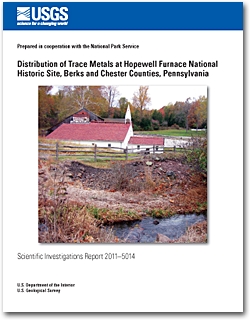Scientific Investigations Report 2011–5014
ABSTRACT
Hopewell Furnace, located approximately 50 miles northwest of Philadelphia, was a cold-blast, charcoal iron furnace that operated for 113 years (1771 to 1883). The purpose of this study by the U.S. Geological Survey, in cooperation with the National Park Service, was to determine the distribution of trace metals released to the environment from an historical iron smelter at Hopewell Furnace National Historic Site (NHS). Hopewell Furnace used iron ore from local mines that contained abundant magnetite and accessory sulfide minerals enriched in arsenic, cobalt, copper, and other metals. Ore, slag, cast iron furnace products, soil, groundwater, stream base flow, streambed sediment, and benthic macroinvertebrates were sampled for this study. Soil samples analyzed in the laboratory had concentrations of trace metals low enough to meet Pennsylvania Department of Environmental Protection standards for non-residential use. Groundwater samples from the supply well met U.S. Environmental Protection Agency drinking-water regulations. Concentrations of metals in surface-water base flow at the five stream sampling sites were below continuous concentration criteria for protection of aquatic organisms. Concentrations of metals in sediment at the five stream sites were below probable effects level guidelines for protection of aquatic organisms except for copper at site HF-3. Arsenic, copper, lead, zinc, and possibly cobalt were incorporated into the cast iron produced by Hopewell Furnace. Manganese was concentrated in slag along with iron, nickel, and zinc. The soil near the furnace has elevated concentrations of chromium, copper, iron, lead, and zinc compared to background soil concentrations. Concentrations of toxic elements were not present at concentrations of concern in water, soil, or stream sediments, despite being elevated in ore, slag, and cast iron furnace products. The base-flow surface-water samples indicated good overall quality. The five sampled sites generally had low concentrations of nutrients and major ions but had elevated concentrations of iron, manganese, and strontium when compared to sites sampled in adjacent watersheds. The background site on Baptism Creek generally had the lowest concentrations and yields of constituents. Low concentrations of nutrients and major ions at all five sites indicate that measured concentrations can be attributed to general land use and geology and not to point sources. Streambed-sediment sampling results indicated higher concentrations of all metals except nickel at sites on French Creek compared to the background site on Baptism Creek. Concentrations of aluminum, cadmium, and nickel were highest in sediment from the sampling site upstream from Hopewell Furnace. The highest concentrations of arsenic, boron, cobalt, copper, iron, lead, manganese, mercury, and zinc were detected at the site just below Hopewell Furnace, which indicates that the source of these metals may be in Hopewell Furnace NHS. The invertebrate community at the background site on Baptism Creek was dominated by pollution sensitive taxa indicating a healthy, diverse benthic-macroinvertebrate community. Benthic-macroinvertebrate communities at sampling sites on French Creek indicated disturbed communities when compared to the background site on Baptism Creek and that the overall stream quality immediately above and below Hopewell Furnace NHS is degraded. The benthic-macroinvertebrate communities were dominated by pollution-tolerant taxa, and taxa were less diverse than at the background site. Habitat conditions at the upstream site on French Creek were good but were degraded at downstream sites on French Creek. The major habitat issues at these sites were related to a lack of stable substrate, erosion, and deposition. Water quality and streambed-sediment quality do not indicate that the degraded benthic-macroinvertebrate communities are the result of poor water quality. Habitat conditions (erosion and sedimentation) and physical alterations (water temperature) from the outfall of Hopewell Lake are the most likely causes of the impaired communities. |
Posted March 23, 2011 For additional information contact: Part or all of this report is presented in Portable Document Format (PDF); the latest version of Adobe Reader or similar software is required to view it. Download the latest version of Adobe Reader, free of charge. |
Sloto, R.A., and Reif, A.G., 2011, Distribution of trace metals at Hopewell Furnace National Historic Site, Berks and Chester Counties, Pennsylvania: U.S. Geological Survey Scientific Investigations Report 2011–5014, 79 p.
Abstract
Introduction
Purpose and Scope
Historical Background
The Iron-Making Process
Distribution of Trace Metals
Ore
Slag
Soil
Cast Iron Furnace Products
Groundwater
Stream Sites
Stream Base Flow
Streambed Sediment
Benthic Macroinvertebrates
Habitat Evaluations
Statistical Summary of Selected Metals
Summary and Conclusions
Acknowledgments
References Cited 31
Appendix 1. Tables A–K